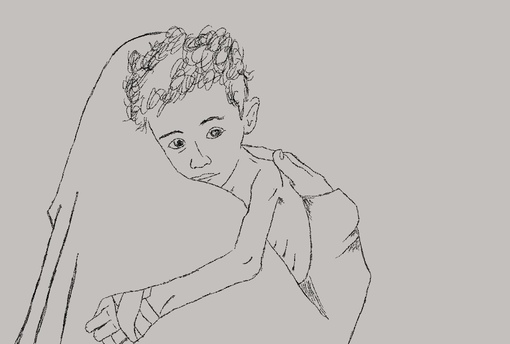
Drawing by Nathaniel St. Clair
The Syrian conflict will soon be into its ninth year, and the Yemen conflict into its fifth year. Both are major humanitarian disasters, with millions displaced amid unimaginable suffering. An estimated half a million have been killed in Syria, and over 100,000 in Yemen.
The West is deeply involved in both conflicts – supporting the opposition in Syria and the Kurdish areas, and providing arms and political support for the Saudi Arabian and Emirati led war on Yemen.
The humanitarian aid provided to both crises is indicative of where priorities, Europe’s in particular, lie.
From 2015 to 2018, the European Union (EU) and European countries have provided some $1.56 bn in aid to the UN Yemen Humanitarian Response Plan (YHRP), while providing roughly fifty percent more for Syria during the same period, $3.2 bn.
In 2018, $4.03 bn was pledged (globally) to the UN’s YHRP. This is less than half the amount pledged to the UN’s Syria Humanitarian Response Plan, $8.96 bn. Furthermore, the Syria campaign received more funding for 2018 than the entirety of the Yemen conflict, some $8.6 bn (2015-2018). Over the same period, $12.6 bn was pledged for Syria. This is a huge difference, despite the number of people affected in both conflicts being similar.
There are 5 million Syrian refugees and 6 million internally displaced, while 80 percent of Yemen’s 22.2 million people – a population on par with Syria’s 23 million – are in need of humanitarian or protection assistance, with 11.3 million in acute need.
At a country level, Europe has been more ‘generous’ regarding the Syria campaign than for Yemen, despite 21 EU countries selling $86.9 bn in arms to Saudi Arabia and the UAE (in 2015 and 2016), some 55 times more than the aid provided, as shown in figures I compiled for Middle East Eye.
France has provided $37.1 mn to Syria compared to $12.3 mn for Yemen (while exporting $17.3 bn in arms to Saudi and the UAE), Germany $1.2 bn compared to $358 mn for Yemen (arms sales of $1.2 bn), the United Kingdom $898 mn for Syria compared to $636.9 mn (arms sales of $4.85 bn), and the European Commission $568 mn compared to $252 mn (although in total the EC has provided $507.3 for Yemen).
There are two main reasons for less aid going to Yemen. The first is that Yemen has not garnered the same media coverage as Syria. At the somewhat cynical level, that is due to Yemen not having the equivalents of Beirut, Amman or Gaziantep nearby for foreign journalists to cover the conflict in relative comfort, as is the case with Syria. It took the grizzly murder of Jamal Khashoggi for the Yemen conflict, and Saudi’s brutal role, to get more international attention.
But the primary reason is that Yemen, the Middle East’s poorest country (which has only gotten poorer since 2015), is not on the shores of the Mediterranean Sea. While Damascus is around 3,200 kilometers from Paris as the crow flies, Sanaa (the capital of Yemen) is over 2,000 kilometers south-west of Damascus.
Yemenis have a lot further to go to flee if they do not want to seek refuge in the country bombing them, Saudi Arabia, or cross Southern Yemen to escape to Oman, or cross the Red Sea at its narrowest point, the appropriately named Bab el Mandeb (Gate of Tears). In short, it is harder for Yemenis to make the perilous journey by land or sea as ‘easily’ as Syrians to get to Europe. While Yemen does have a different narrative, it is also a victim of its geography.
Ultimately, it is the fear of Syrians fleeing to the EU that has prompted European countries to open their purse strings and provide more aid to Syria than to Yemen. This is also true of the other major donors to the UN campaigns, the USA, Canada and the Arabian Gulf countries, which are strategic allies of Europe.
Additionally, this is why Europe has put more weight behind calls to end the Syrian conflict (as well as to spite Moscow) than the Yemeni war, while also, despite a few exceptions, continuing to sell arms to Saudi Arabia and the UAE.
Such strategic humanitarian aid has abetted authoritarianism. In the case of Yemen, aid is being used to offset the tainted profits of arms sales to the absolute monarchies of Saudi Arabia and the UAE.
Regarding Syria, the refugee crisis has muted European criticism of Turkey, Jordan and Egypt. Turkey’s President Erdogan has played the EU like a fiddle, as he knows Europe wants the 3.5 million Syrian refugees in Turkey to go no further West than the Bosporus. Egypt’s President Sisi has also utilized the crisis to get a ‘carte blanche’ from Europe in return for ‘stabilizing’ the country and preventing Syrians, but also Egyptians and others from the Middle East and Africa, from trying to cross the Mediterranean moat and scale the walls of Fortress Europe.
Fortress Europe wants to keep all of the ‘barbarians at the gates’ out. The difference in aid provided to Syria and Yemen is a strong indicator of such a strategic policy: the closer the Other is, the more aid will be provided.